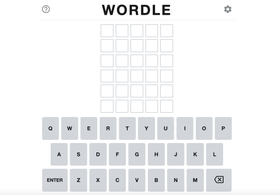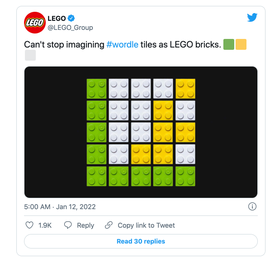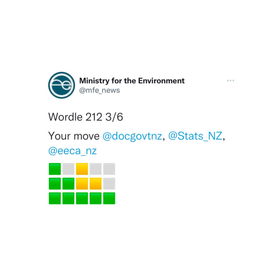How to Build Brand Recall in a Clickless World
Brand awareness is dwindling in organic search. Here's your strategy for building brand equity and recall by leveraging brand awareness. Learn more here.
Read More
There are two types of people in the world: Those who spring out of bed every morning eager to solve a daily word puzzle versus those who refuse to participate in the sudden craze. No matter which category you fall into, you’ve undoubtedly seen the grids of green, yellow, and gray squares on social media.
But how did Wordle — a software engineer’s pet project turned The New York Times’ newest game — captivate the world? And what can brands learn about its sudden meteoric rise? Toss your phone to the side for a few minutes: We’re exploring the world of Wordle.
SHORT ON TIME? CHECK OUT THIS 2-MINUTE VERSION:
The premise of Wordle is deceptively simple: Each day, the game gives users six opportunities to guess a five-letter word. As players guess, the game uses green, yellow, and gray colors to indicate whether the letters you’ve punched in are in the correct spot for the word.
But before the game transformed into a cultural phenomenon, it was simply a pet project for Josh Wardle, a Brooklyn-based software engineer who wanted to design something fun for his puzzle-loving partner. After launching the app, which he named after himself, Wardle shared it with his friends.
In November 2021, it had 90 daily players. By early January 2022, 300,000. In mid-January, two million.

Wordle’s interface is beyond simple.
Around the same time, one superfan in New Zealand started using color block emojis to display her results to friends on social media. It piqued Wardle’s interest — he quickly built a feature that allowed players to share their results in the same color-block grid configuration that resembled a Rubik’s Cube.
Players began posting their Wordle results across social platforms, from Twitter to Facebook. Some with shorter grids bragged about their mastery of the English language, while others who used up all six guesses bemoaned about their unlucky streaks. As these colorful grids were posted across the internet, it seemed everyone was talking about Wordle, from celebrities, to influencers, to brands, and even politicians.
Wordle’s interface is beyond simple.
Wardle couldn’t believe it. Speaking to The Guardian, he said: “[Wordle] going viral doesn’t feel great, to be honest. I feel a sense of responsibility for the players. I feel I really owe it to them to keep things running and make sure everything’s working correctly.”
Barely four months after he created the game, The New York Times purchased it for a “low seven-figure sum. “The game has gotten bigger than I ever imagined,” Wardle wrote in a statement. “I'd be lying if I said this hasn't been a little overwhelming. After all, I am just one person.”
If you’re an avid Wordle player, don’t worry about the change in ownership. Both Wardle and The New York Times say the game will remain freely available to players, with streaks and scores preserved.
When was the last time you interacted with an app with no ads, no paid “power-ups,” no mandatory account creation, no subscription features, and no push notifications?
That’s why Wordle feels so refreshing — it’s reminiscent of the internet from a simpler time, where we had playful, innocuous apps like iBeer (the beer-drinking simulator). Unlike the apps of 2022 that aggressively compete for your attention, time, and money, Wordle is deliberately designed not to collect your data, promote ads, be played nonstop, monetize your gameplay, and foster addictive behavior.
We live in a bingeable society focused on maximizing engagement, though Wordle is the antithesis of this culture — and its success demonstrates that consumers support it.
As the pandemic rages on, Wordle provides users with a sense of comfort and even joy.
“I get emails from people who say things like, ‘Hey, we can’t see our parents due to [COVID-19] at the moment, but we share our Wordle results each day,’” said Wardle.
The game’s simple premise serves as a low-effort tool for connection. Factor that into the game’s communal experience aspect, where people worldwide can unite around solving the same puzzle. Just take a peek on Twitter, where players share their frustrations, favorite starting words, and memes related to the word of the day.
The grids were a game changer for Wordle. With hundreds of thousands of green, yellow, and gray boxes lighting up social media feeds with little to no context, it inevitably piqued non-players’ curiosity.
Celebrities and brands participating in the conversation only strengthened this formula for mass participation. What was surprising, however, was which retailers and organizations capitalized on the game to promote their own brands.

Points to LEGO for this one
LEGO posting an image with green, yellow, and gray LEGO tiles? Sure, that might be expected. Nokia Mobile using the Wordle grid to remind users of Snake, an OG mobile game? Pretty neat. But the Library of Congress and government departments worldwide tweeting about Wordle? Now that probably wasn’t on your Bingo card.

New Zealand got in on the fun.
If you’re not a Wordle player and still don’t understand the obsession, here’s what you need to know: Wordle is a genuinely great game.
Despite its simplicity, it’s also challenging. Whether it’s warranted or not, successfully guessing the word of the day can unlock a massive sense of accomplishment — and who doesn’t like that?
Wardle may have sought out to create a nice gift for his partner, but the massive success of his namesake game offers brands major insight into what it takes to create a viral product:
Consider how your product makes your customers feel. What itch does it scratch? What frustration does it solve? Make sure your product has a value proposition rooted in emotion rather than just features and attributes.
Appeal to people’s needs for connection. It’s year three of the pandemic, and most of us are starved for human connection. If your product or brand can facilitate relationship-building and communication, you’re on the right track.
Treat your customers respectfully and honestly. Whether it's spamming shoppers with promotional emails multiple times a day or purposefully designing a complicated return and exchange process, there are too many brands out there willing to destroy shoppers’ trust in return for more revenue. In 2022, let’s strive to build more purpose-driven and ethical brands.
Last updated on March 11th, 2022.